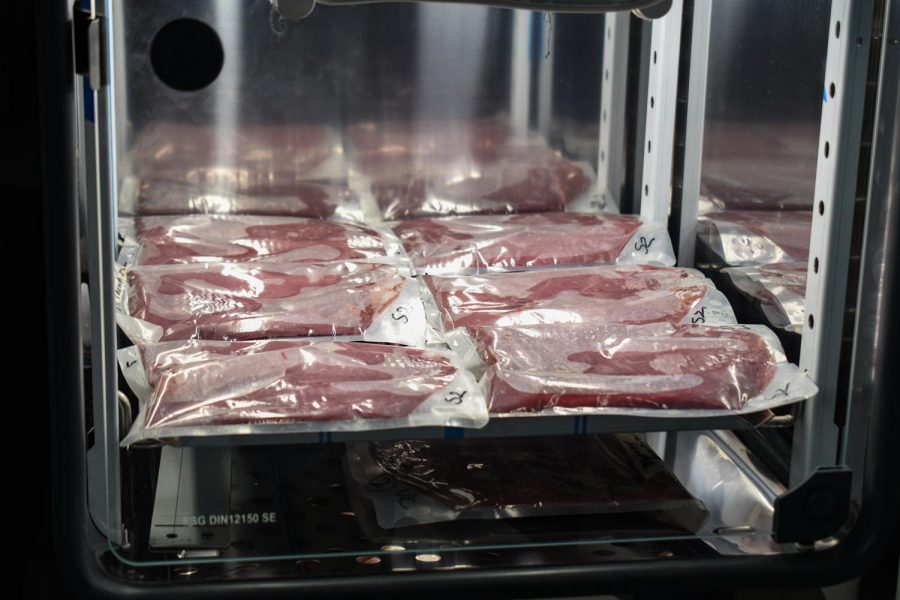Researchers increase shelf life of macaroni and cheese
Project extends food’s preservation to five years if refrigerated
Several food samples sit in an incubator used for testing at one of the laboratories in Hulbert Hall.
September 29, 2019
WSU researchers increased the shelf life of macaroni and cheese to three years by using sterilization and coating technologies.
Shyam Sablani, Biological Systems Engineering associate professor and director of the project, said the project began in 2016. Five graduate students are working on this project.
He said his team received funding from the United States Department of Agriculture in December 2015. They applied in 2013 but did not receive funding. In 2014, they reapplied and were awarded funds. However, the review process took nine months.
The research team is collaborating with Bowling Green State University and with four polymer-processing companies, Sablani said. They are also working with WSU Regents’ professor Juming Tang, co-director of the project.
Tang developed a microwave-assisted sterilization system (MATS) to sterilize food products, Sablani said. Food is packaged and sterilized in plastic because metal products do not work with microwaves. Because of the volume metric heating of microwaves, the sterilization process is shorter compared to conventional steam heating.
Sablani said the plastic packaging films required many modifications.
“Before we started doing research, we found that these plastic films allowed a lot of transmission of gases: oxygen and water vapor,” he said. “If the oxygen goes in, it reacts with the food.”
The plastic films they currently use are coated with metal oxide, Sablani said. This type of coating acts as a barrier and absorbs oxygen. It protects the film and prevents oxygen from ruining the shelf life of food.
Sablani said this metal oxide coating in the plastic films initially did not perform well. When his group tested it, they found cracks on the packaging films. Oxygen can enter through those cracks, which meant the coating was failing.
The polymer-processing companies they work with redesigned their plastic films and coating technology based on the researchers’ feedback, he said. It took multiple tests before the metal oxide-coated packaging films performed successfully.
Sablani said his team’s contribution is mostly based on improving the coating process and technology by testing the products using MATS. A third-party lab in Seattle is performing microbiological evaluations on the products and certifies whether the food is safe to eat.
WSU researchers are also working with the U.S. Army, Sablani said.
“They are interested in processing military rations using new technology, microwave sterilization technology, which Tang has developed,” he said. “They are also interested to see the right packaging, which can keep this food high-quality for three years.”
Sablani said his team uses accelerated shelf life testing where they store food products at 100 degrees Fahrenheit for six months. If the food is still good, then it means the food product will be good for three years at room temperature. A nine-month storage is equivalent to about five years.
Juhi Patel, a graduate student and one of the researchers involved, said they received their macaroni and cheese ingredients from the U.S. Army. They also bought local cheese products. The researchers had to test various quality parameters, like nutrition quality. This was a hard task since macaroni and cheese has a lot of ingredients.
“Lab members help me out to get the preparation packaging,” Patel said. “Once we process them, [we coordinate] with the Seattle company for the testing and then send those packages to [the U.S. Army] for the sensory analysis.”
Patel said they carry out their tests in two labs at WSU’s Food Science and Human Nutrition Building.
The U.S. Army receives the tested macaroni and cheese pouches in their facility in Natick, Massachusetts. They store it for six or nine months. Afterwards, a sensory panel composed of trained people will taste the food and describe the food’s quality parameters, including color, appearance, flavor and texture. The panel will give a score out of nine, with nine being the best.
Sablani said his team will prepare about 300 pouches of macaroni and cheese for the U.S. Army. The Army will then give them to soldiers in the field who will try the food.
“That will be the ultimate test,” he said.
WSU researchers are also planning to reach out to NASA soon, Sablani said. NASA is interested in food that has a shelf life of five years, and they would have to send the food for testing to the International Space Station.
“In the case of space, there is no scope of failure,” he said. “You cannot say, ‘Well, it’s not working.’ This is not the case because there’s no hospital. There’s nothing there.”
Although their primary targets were the military and NASA, Sablani said some food companies might be interested in their project to prepare for emergency rations, especially during natural disasters when people need food that have long shelf lives.
They are looking to transition from synthetic plastic to bio-based packaging to be environmentally friendly, Sablani said. Bio-based products are not good for wet products and melt at high temperatures. They are looking into this issue and hope to find a solution.
“The public also needs to know that as scientists, we are aware of the limitations of some of these processes or packages. But there are situations where these are the only answers we have, at least in this moment,” he said.
Sablani said they are planning to decrease the amount of materials they use in their products to reduce waste. Intelligent packaging is a technology they are looking into. This technology will have a color-coded sensor on the packaging. If it is green, the food is still good.
He said they are looking into combining the use of smart phones and the intelligent packaging technology. People could use their phones to scan the packaging’s sensor, and they will receive information about the food’s remaining shelf life. Sablani said his team is writing grant proposals to receive funding for this intelligent packaging technology.









